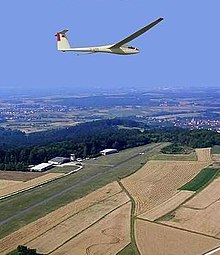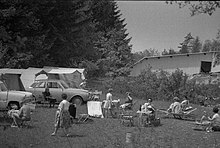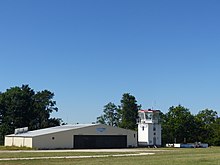Hetzleser Berg airfield
| Hetzleser Berg airfield | ||
|---|---|---|
|
|
||
| Characteristics | ||
| ICAO code | EDQX | |
| Coordinates | ||
| Height above MSL | 533 m (1749 ft ) | |
| Transport links | ||
| Distance from the city center | 4 km northeast of Neunkirchen am Brand, 23 km north of Nuremberg |
|
| Basic data | ||
| opening | 1963 | |
| operator | Flugsportverein Erlangen-Nürnberg e. V. | |
| Start-and runway | ||
| 07/25 | 608 m × 30 m grass (of which 608 × 7 m asphalt) | |
The Hetzleser Berg airfield is a special airfield approximately four kilometers northeast of Neunkirchen am Brand in Upper Franconia . It is operated by the Flugsportverein Erlangen-Nürnberg e. V.
geography
The airfield is located 17 kilometers north of Nuremberg Airport on a table mountain at an altitude of 533 m above sea level. NN . This witness mountain is located on the western edge of Franconian Switzerland . The Franconian Alb extends to the east and the Regnitz valley to the west .
history
The Nuremberg Aviation Club emerged from a merger of the Nuremberg Aviation Association and the 1st Nuremberg Glider Club " Friends of the Friesener Warte ". The Fliegerclub Nürnberg eV (FCN) was a hiking club from the summer of 1957, when glider operations at the former “ industrial airport Fürth ” had to be stopped. The members moved from their base (workshop) in the Großweidenmühlstrasse in Nuremberg on the weekends with a winch, launch vehicle etc. and attached glider trailers to suitable airfields to fly there. Places were Ansbach-Katterbach , the military airfield Erlangen (along with the Air Sports Association Erlangen = FVE) Greding, the Friesener waiting and the former Märzfeld ( Nazi Party Rally Grounds ) and the military training area Hainberg in Nuremberg.
On April 7, 1963, the government of Upper Franconia approved the testing of a site on the Hetzleser Berg. The official approval for the construction of an airfield was given on January 28, 1964. Soon after, the construction of a storage hall for equipment and aircraft trailers began, which was inaugurated on June 21, 1964.
The topping-out ceremony for a “real” aircraft hangar was celebrated as early as 1966 and the aircraft no longer had to be disarmed every evening. The FCN clubhouse and some living and sanitary rooms are located below the hall. A fuel bunker with space for a diesel power generator was built next to the hall.
In the summer of 1969, further use of the airfield in Erlangen (today Röthelheimpark ) by the FVE was no longer possible and the FVE and the FCN decided to jointly use the area on Hetzleser Berg. It was also decided from then on to run the training across clubs (again).
In 1971, the FCN self-built the first motor glider Scheiben SF 25 D-KAFI and replaced the previous, very noisy Stinson L-5 D-ELKO tow plane with a Piper PA-18 D-EBAW. The latter has served as a towing machine ever since and has been constantly adapted to the increasing noise protection requirements. The age of plastics also arrived on the Hetzleser Berg in 1971 with an LS 1c (the world champion aircraft from 1970 in the standard class and 2016 in the club class). The Erlangen Aviation Association was able to put the new Kurt Schultheiss-Halle into operation.
In June 1973 the operating permit as a special landing site was issued and in September 1975 the new tower was inaugurated. Furthermore, a small clubhouse was created for the members of the FVE.
In 1974 the FVE got the Bergfalken IV D-3699 and the FCN the D-3701. The new Falcons were better suited for the upcoming retraining to plastic sailors than Mü-13, Bergfalke II and Specht. The first Astir CS arrived in 1975, followed by a twin Astir in 1978.
In September 1982 a major flight day took place with around 50,000 visitors, during which the freshly restored Messerschmitt Bf 109 D-FMBB was presented to the public for the first time and the befriended motor aerobatic world champion Manfred Strossenreuther showed his skills. This flight day enabled the Nuremberg Aviation Club to asphalt the runway in two steps and to further modernize the aircraft fleet. In 1983 an LS4 (the 1981 world champion aircraft) completed the fleet. In the meantime, the FCN and its workshop were also approved as LTB in 1986 . In May 1987, the now completely new slope was inaugurated, as was the third hall with a workshop instead of the old storage shed. In October 1987 long-time flight instructor and training manager Rudi Niegratschka celebrated his 10,000th birthday. Begin. In the mid-1980s, the aircraft parks of both clubs were almost completely converted to modern plastic gliders. There were a few more quite successful flight days, but due to the Ramstein disaster on August 28, 1988, the era of the large flight days at Hetzleser Berg ended due to the subsequent high editions. In January 1995 the airfield got its ICAO identification EDQX.
At the end of 1998 the Bergfalke IV was replaced by an ASK 21. This meant that the entire training was possible on plastic sailors right from the start. Between 1998 and 2010, several other structural measures were carried out, the most important of which was the height adjustment and the leveling of the eastern area beyond the street as an extension of runway 08 (see picture). Also very important was the felling of some trees in the extension of the railway to the west, which in the meantime had grown into a considerable obstacle. Therefore, threshold 08 was moved further east and the usable landing distance shortened (see picture).
In 2000 it was connected to the public power grid and the site was also approved for UL operation. Furthermore, in addition to joint training, both clubs decided to use the motor gliders and ULs together. On September 21, 2013, the members celebrated the 50th anniversary of the airfield. However, due to the decreasing interest in gliding, it became increasingly clear that a final merger of the previous clubs would bring some logistical advantages.
In 2014/15, the gliding group spun off from the FCN. On April 19, 2015, the merger with the FVE took place as the "Flugsportverein Erlangen-Nürnberg". Until then, the FCN was the sole owner of the site. The previous motorized flight group of the FCN continues under its old name and flies as ever at Herzogenaurach airfield . At a touring exhibition in 2019, the association celebrated the 111th anniversary of its founding associations, which began with the "Nürnberger Verein für Luftschiffahrt eV" in 1908.
Airfield and equipment
The airfield is approved for aircraft of all types up to 2000 kg maximum take-off weight (MTOW).
The tower , three halls and a lounge are on the south side of the square . There is a petrol station, but there is no sale to third-party pilots.
There are also two campsites with an additional shower and toilet house. Since there is no water connection, the process water is collected from the hall roofs and stored in an underground tank. Drinking water, on the other hand, has to be delivered by tanker.
education
There are currently (2020) a total of 5 plastic double-seaters (1 × ASK 21 , 1 × Grob G 103 Twin Astir II, 1 × Grob G-103 Twin III, 2 × Duo Discus ) and two single-seaters of the Grob G type 102 available. For nostalgic reasons, there is also a K 8 classic car . Two SF 25c are available for motor glider training .
After the training, the following are available: 1 × LS1d (nostalgia pilot from 1971), 1 × LS4b , 1 × LS8 , 2 × Discus CS , 1 × Discus 2 CT with homecoming assistance.
Two Piper PA-18s with 150 or 180 HP and a UL T96 Sting serve as tow planes.
Theoretical lessons and workshop work are carried out in Erlangen in winter, and a fully equipped workshop is available in one of the halls in summer.
In the past 58 years, hundreds of glider flying students have been trained at Hetzleser Berg across all clubs, some of them coming from the respective model flying groups of the two original clubs.
Glider aerobatics, motor gliders and ultralight training are only offered further.
The 50 km long-distance flight required for a glider license traditionally leads to Bamberg and back, with the airfields Dobenreuth (6 km), Feuerstein Castle (17 km), Friesener Warte (23 km) and Bamberg (27 km) located on the route.
Since 1964 there have been two air camps a year on Hetzleser Berg, each in the first two full weeks of the Bavarian Whitsun and summer holidays.
Incidents
- On July 27, 2003, a Grob ASTIR-CS glider had an accident while approaching EDQX. It touched down about 200 m before 07/25, scratched a mound of earth, turned a Ringelpiez and was badly damaged.
- On May 28, 2010 a touring motor glider of the type Scheibe SF 25 C did not come up to altitude in time after takeoff and collided with obstacles. The machine was badly damaged and one person was injured.
- On August 9, 2018, a single-engine high - wing aircraft overturned on landing and came to rest on the roof. There was considerable material damage, the 70-year-old pilot got away with the horror.
- On June 21, 2019, a Twin Astir III glider crashed into a neighboring cherry orchard in a false start from a height of around 30 m. The aircraft was totally destroyed, the pilot and his trainee pilot were trapped and were recovered seriously injured.
Transport links
The best way to get to the airfield is from Neunkirchen a. Brand or Igensdorf ( B2 ), Ermreuth and Gleisenhof . If the approach is via the village of Hetzles , the last 400 m must be covered over a footpath. In the village of Gleisenhof, which is adjacent to the airfield, there is a stop for the VGN bus route 211
See also
Web links
- Flugsportverein Erlangen-Nürnberg eV
- EDQX at oberpfalz-luftbild.de
- Aviation map for Hetzleser Berg airfield on SkyVector.com
Individual evidence
- ^ Chronicle of the Fliegerclub Nürnberg eV
- ↑ BFU-Bulletin 07/2003, investigation report 3X162-0 / 03 (.pdf)
- ↑ BFU Bulletin 05/2010, investigation report BFU 3X063-10
- ^ Press report Nordbayern.de from August 10, 2018
- ↑ Press report tvo.de from August 10, 2018
- ↑ Press report Nordbayern.de from June 21, 2019








